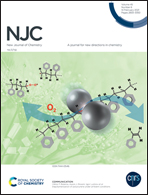Cadmium sulfide quantum dots anchored on reduced graphene oxide for the electrochemical detection of metronidazole†
Abstract
In this research, the metal–organic-based synthesis of cadmium sulfide quantum dots (CdS QDs) was performed. The CdS QDs were anchored on reduced graphene oxide (rGO) nanosheets using a simple sonication technique; this can enhance the electron charge transfer properties of the CdS QDs. The successful formation of the CdS QDs@rGO composite was revealed using various analytical techniques, such as X-ray diffractometry (XRD), Fourier-transform infrared spectroscopy (FT-IR), Raman spectroscopy, transmission electron microscopy (TEM), and X-ray photoelectron spectroscopy (XPS). Optical and morphological analysis revealed that the composite took the form of a well-dispersed suspension. The as-prepared composite was fabricated on a glassy carbon electrode (GCE) for the electrochemical detection of metronidazole (MTZ). Owing to the synergistic effect between rGO and CdS QDs, a superior electrochemical response was obtained using cyclic voltammetry analysis. Quantitative analysis using the differential pulse voltammetry (DPV) technique revealed a wide linear MTZ concentration range from 0.1 to 203.1 μM with a low-level detection limit of 0.053 μM. Furthermore, the practical applicability of the proposed electrode was assessed in milk samples with satisfactory recovery results.



 Please wait while we load your content...
Please wait while we load your content...